Comfrey – What’s the safe way to use it? (& Why You Should)
Comfrey (Symphytum officinale) may show up in your yard, but you're not likely to find it in the herbal supplements. We'll share why it has a questionable reputation, and tips to use it safely.
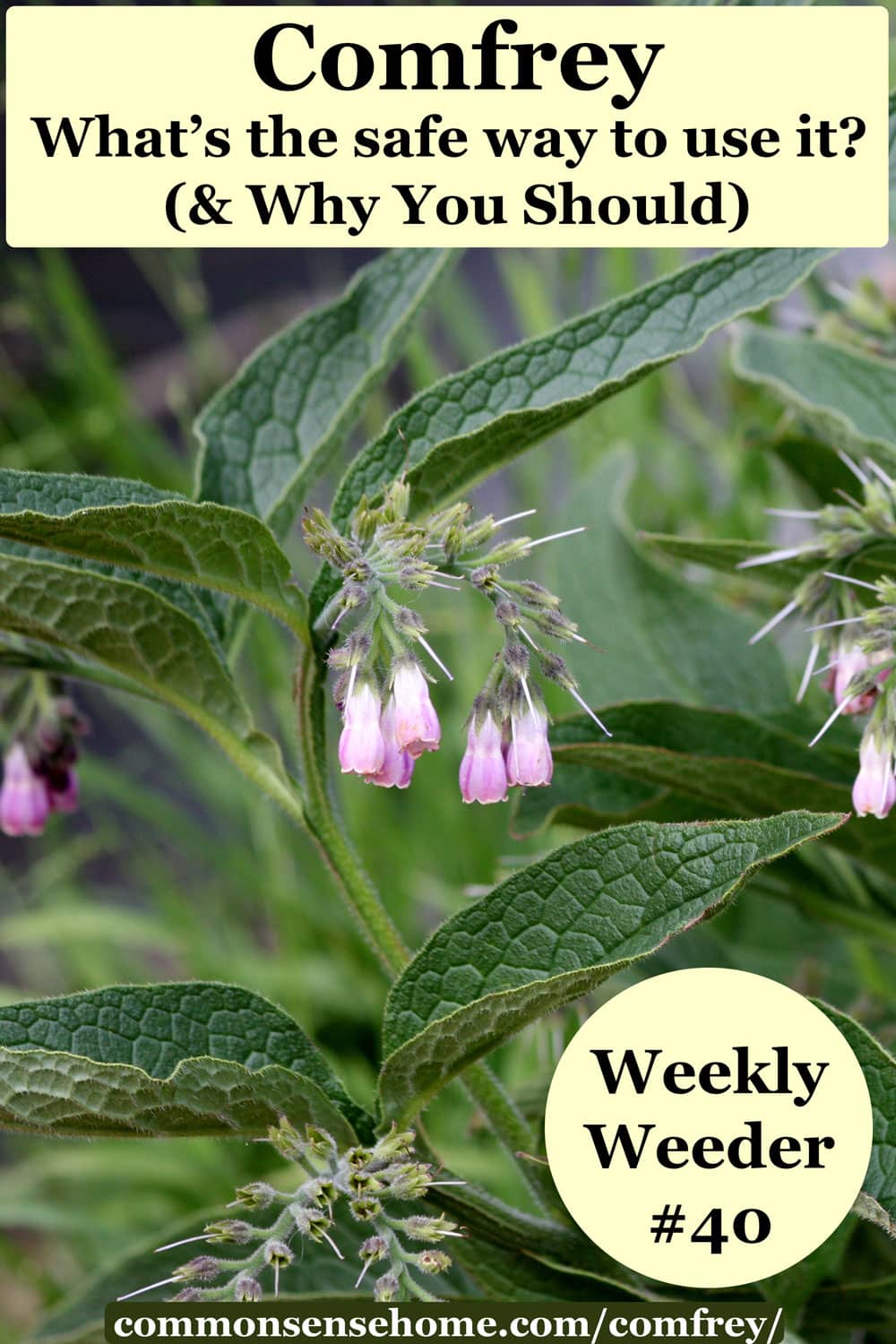
Range and Identification of Comfrey
Comfrey is native to Europe through Siberia, but grows throughout much of the U.S. and up into Canada. It prefers moist soil, and is often found as a garden escapee. Russian comfrey (S.x uplandicum) is a hybrid between common comfrey and prickly or rough comfrey, and prefers drier ground.
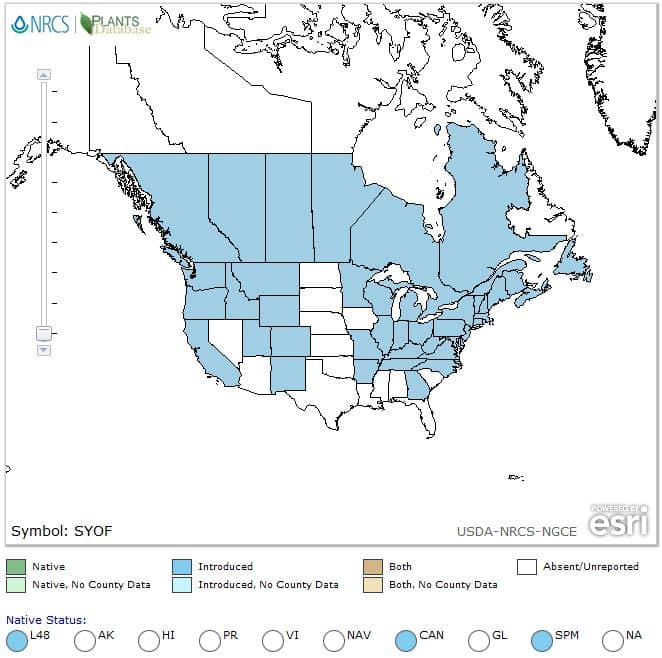
Symphytum officinale is a perennial, blooming in the spring/summer and dying back in fall/winter. It has a dense, clumping habit and grows up to 3 feet in height. Flowering stalks have leaves attached in an alternating pattern up the stem.
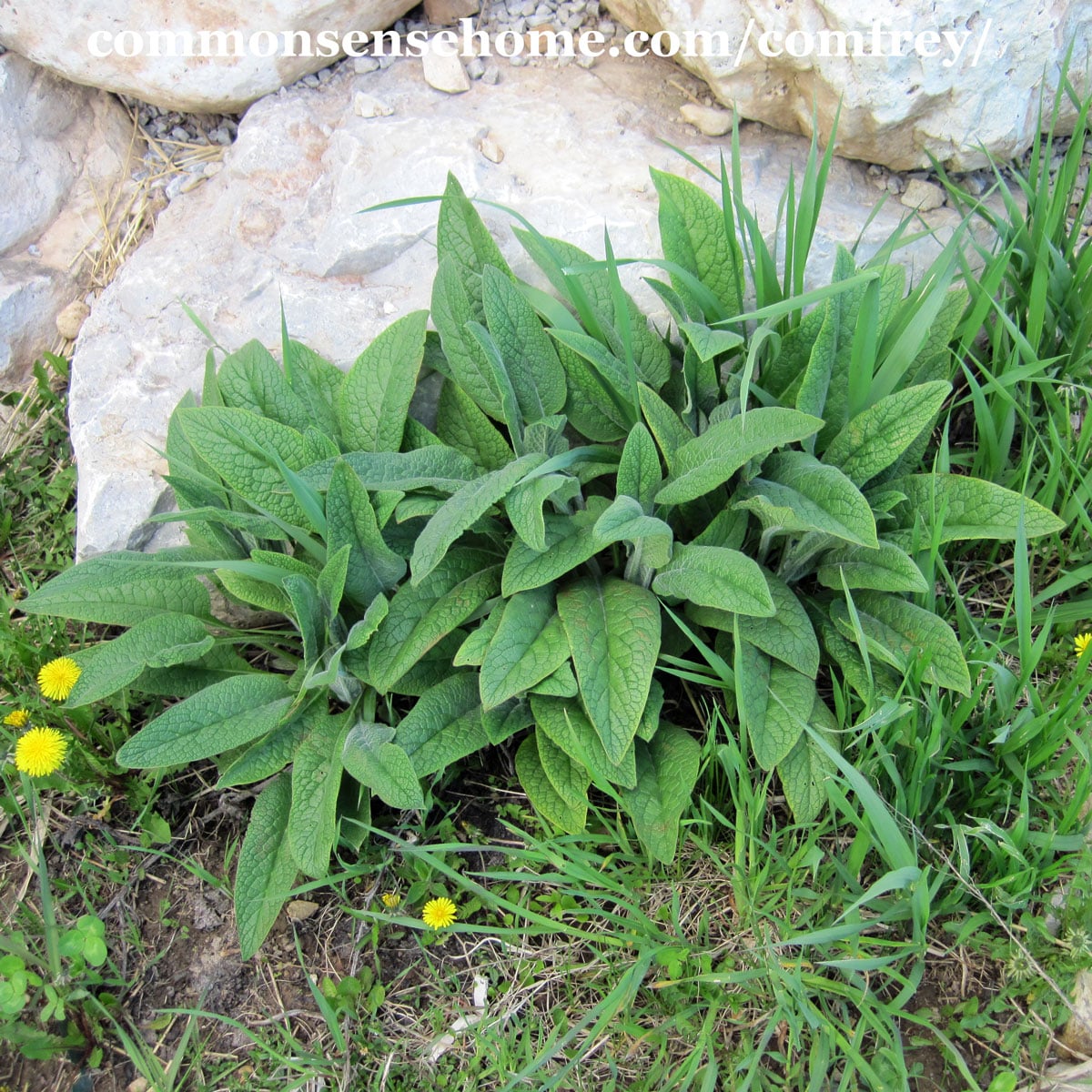
Flowers appear in clusters at the top of the stem. They are delicate and bell-shaped, with only a slight aroma. The blooms measure about 1/2 ” in length, and come in an assortment of colors including white, pink and blue.
The plant looks similar to foxglove before flowering, but foxglove flowers are larger and more showy. Make sure you have a positive ID, as foxglove is toxic.

Comfrey leaves are lance shaped, and reach up to 1 1/2 feet in length. Like borage, the leaves are hairy and rough. (Comfrey is in the borage family.) As you can see, the veining is quite pronounced.
On the leaf stem of common comfrey, there are small green wings that flair out on either side of the stem. Rough comfrey has no flare at the base of the leaf, Russian comfrey has some.
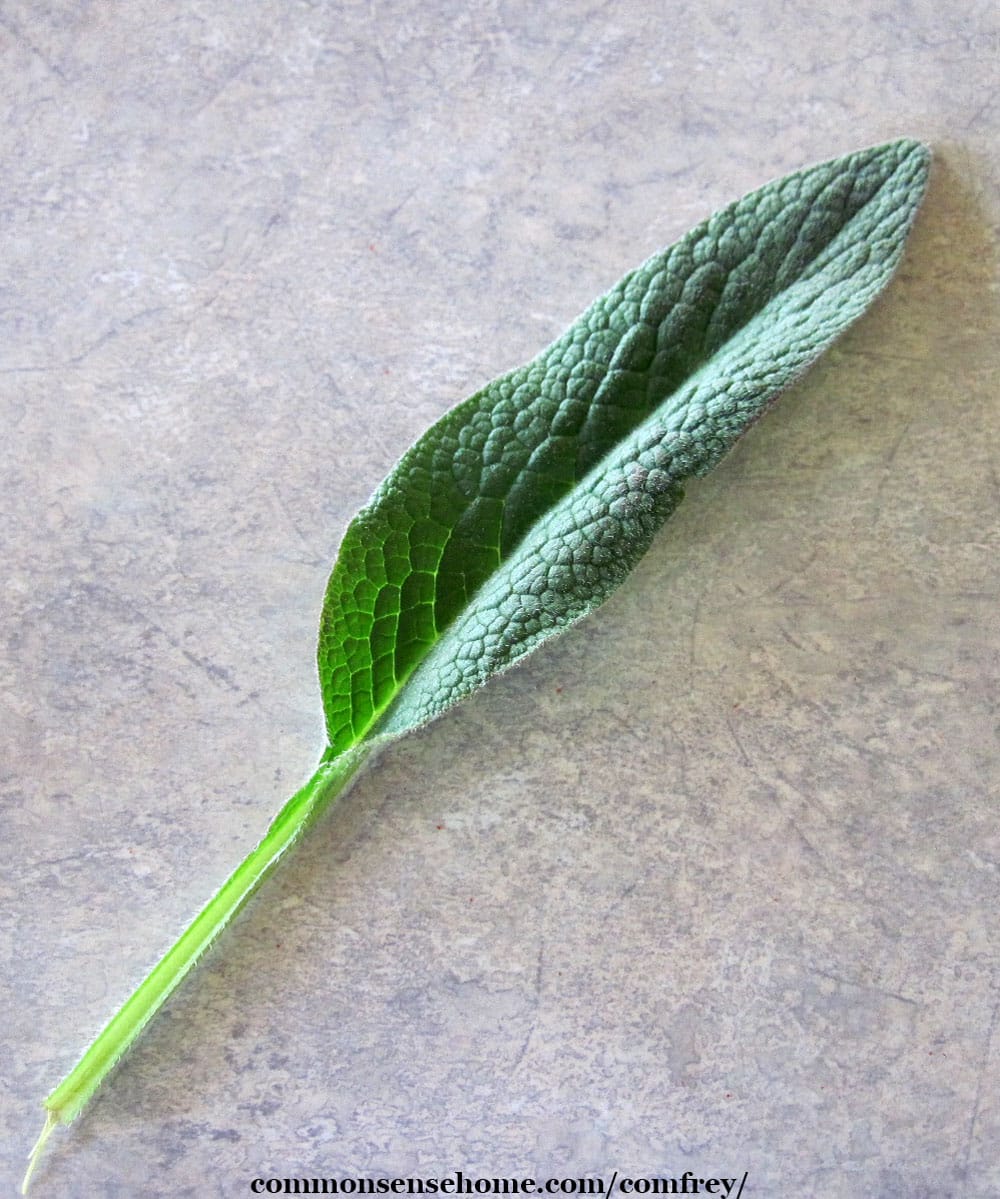
Be warned, comfrey may try to take over the garden. Common comfrey spreads more readily than Russian comfrey, and also self-seeds.
The roots have a branching habit, forming dense clusters that are difficult to remove. They are brittle and break easily, and a new plant will regrow from the leftover bits. (Don't plant them in a spot unless you're sure you want them there.) The roots are dark brown on the outside and white on the inside and measure less than 1/2 inch in diameter.
Why is Comfrey Illegal in the US?
Comfrey contains pyrrolizidine alkaloids, which are naturally occurring plant toxins. If consumed in large amounts, these can be toxic to the liver. In 2001, the Food and Drug Administration advised dietary supplement manufacturers to remove comfrey products from the market.
From their statement:
These plants contain pyrrolizidine alkaloids, substances which are firmly established to be hepatotoxins in animals. Reports in the scientific literature clearly associate oral exposure of comfrey and pyrrolizidine alkaloids with the occurrence of veno-occlusive disease (VOD) in animals.
Is Comfrey Really Toxic?
They're worried about liver damage and liver disease. The thing is, most of the studies showing adverse effects used extremely large amounts of the herb over long periods of time. Some used the isolated compounds instead of the whole herb. Different species were lumped together, and they don't all have the same amount of the compounds.
Russian comfrey has higher pyrrolizidine alkaloid levels than common comfrey. Mature leaves have a much lower concentration of the toxins than the roots. Many herbalists now recommend alternative herbal medicines for internal use, just to be safe.
Is it Safe for Animals?
Illinois Wildflowers notes that many bees enjoy the flowers, but mammals, like humans, may have problems ingesting the plant.
Horses, cattle, goats, and pigs are susceptible to being poisoned; apparently sheep are more resistant to adverse reactions.
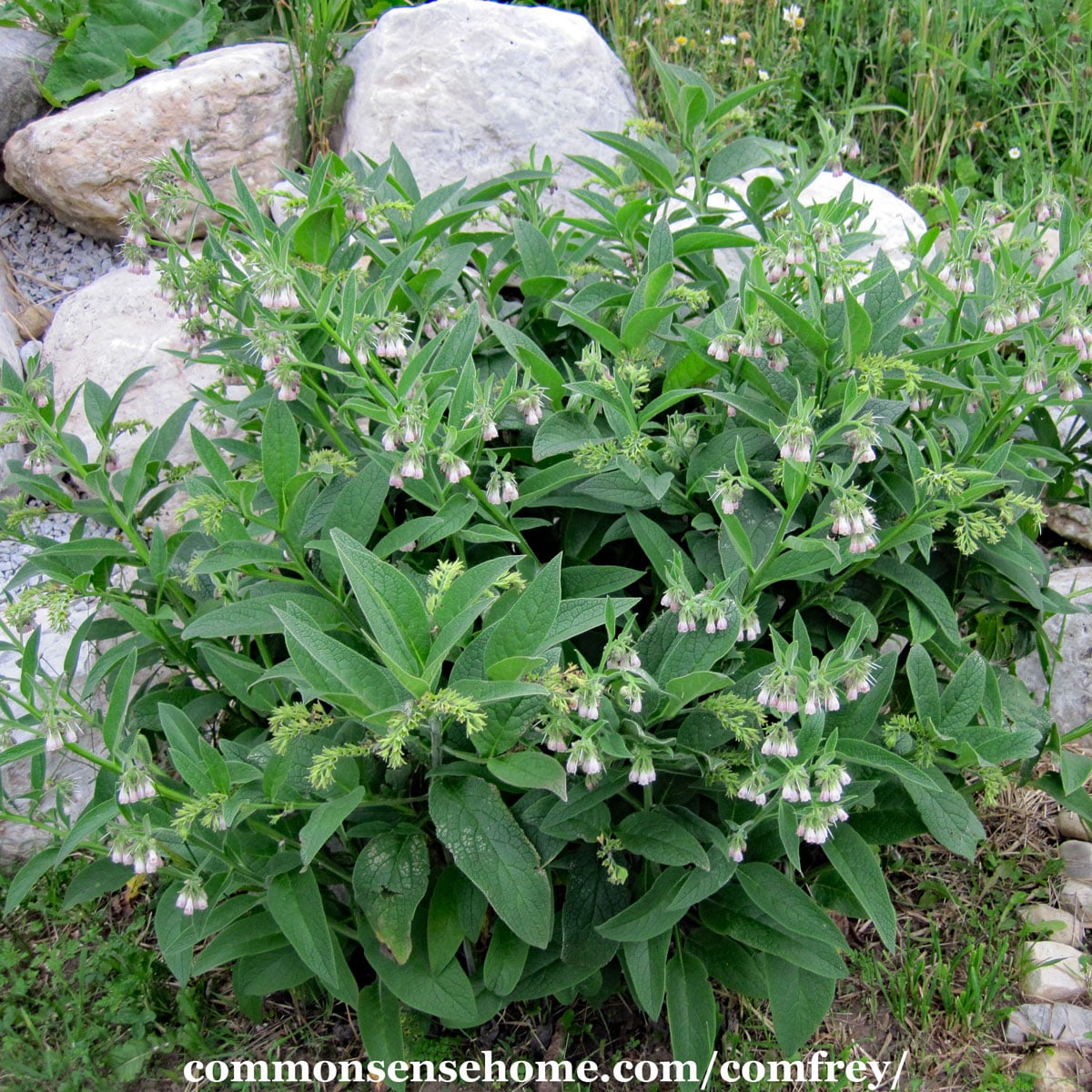
Safe Uses of Comfrey
As its many folk names suggest, comfrey is one of the best herbs for healing broken bones, sprains, strains, bruises, and tears. One of the active compounds in comfrey is allantoin. This anti-inflammatory chemical stimulates cell proliferation and supports the immune system.
The plant also contains tannins, mucilage, gum, resin and volatile oil. The roots were commonly used for bronchitis and other chest complaints, and for stomach issues such as ulcers, but now other herbs are generally recommended. The Holistic Herbal discusses more of these other uses.
Backyard Medicine uses the roots and leaves for a topical comfrey poultice. Dig up the roots, clean and chop into short lengths. Blend with an equal amount of fresh comfrey leaf and just enough water to mix. Puree until relatively smooth.
Apply the puree to a piece of gauze and place over the affected body part. Cover with breathable wrapping, and replace daily.
Try the poultice for:
- broken bones
- sprains
- sports injuries
- bruises
- surgical scars
I had a chance to check out the healing properties of comfrey first hand when I sliced my fingertip open. The cut was about one inch long and 1/8 inch deep at the deepest. It bled like crazy, so I knew the wound had been flushed out.
I made a compress of fresh comfrey leaves and dried yarrow, which is antibacterial and also known for treating wounds. I kept the compress on it for 24 hours, and kept it covered for another 24.
The cut happened Monday night, and this is what the wound looks like on Wednesday morning. No scab, no scar, no pain – which is great, because I still have a lot of canning to do. (More on comfrey's wound healing effects here.)
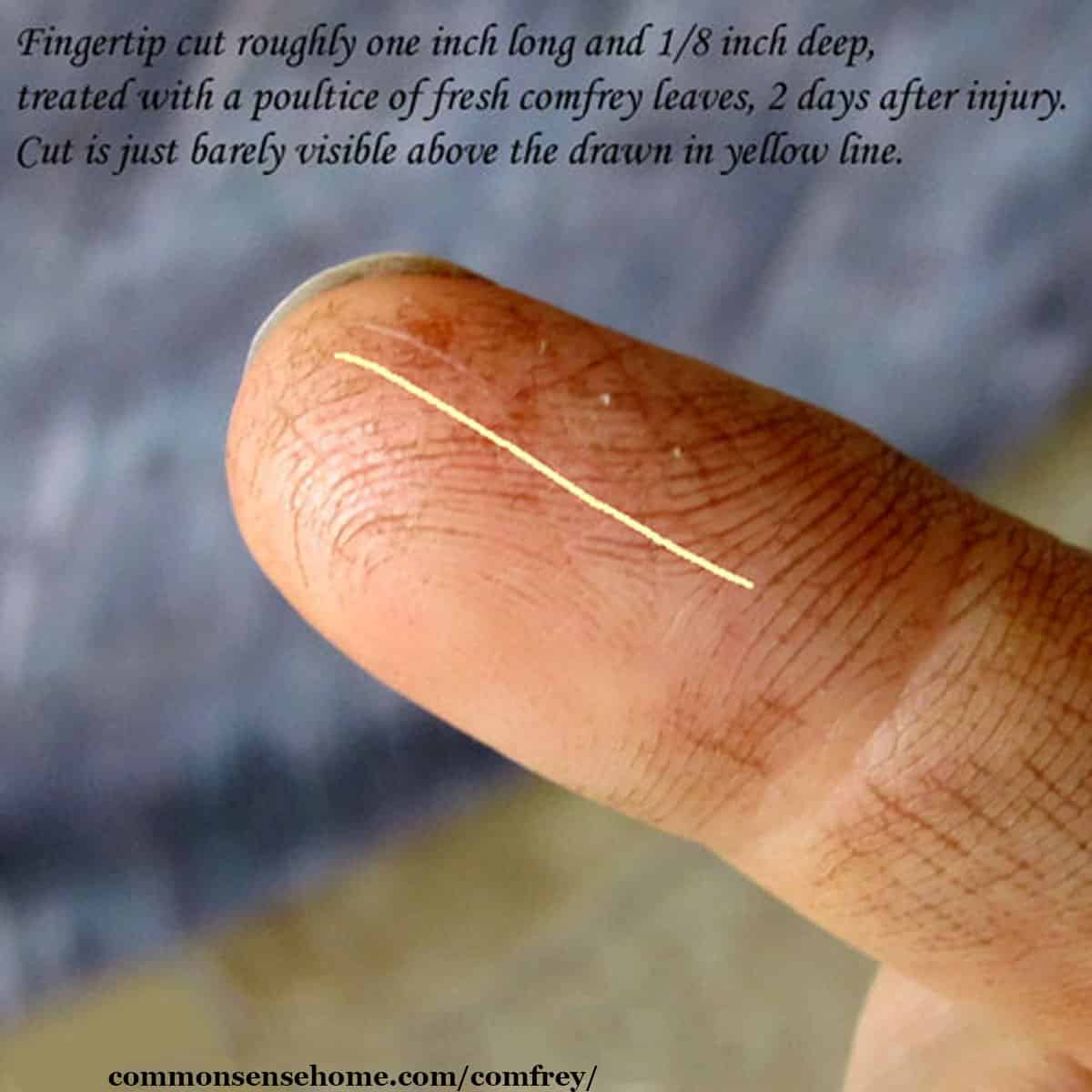
Try Comfrey Salve to Speed Up Healing
For your herbal medicine cabinet, dry the leaves and infuse them in olive oil, then turn the oil into a salve by adding beeswax. Heat 10 fluid ounces of infused oil with 1 ounce of grated beeswax until the wax melts. Allow to cool slightly, then pour into containers. (See more information on infusing oils here.)
Try the salve for:
- arthritis
- rheumatism
- bursitis
- tendonitis
- phlebitis
- glandular swellings
- pulled muscles
- injured joints
- back injuries
- tendons
- ligaments
Comfrey may improve circulatory conditions, such as varicose veins and spider veins. Backyard Medicine also suggests that it may be helpful skin issues, like healing old wounds, such as surgical scars, and minor cuts.
Do not use comfrey for topical treatment of deep cuts or puncture wounds. It may cause the wound to close at the top before it heals underneath, increasing the risk of abscess/infection.
Don't have time to make your own salve? Try Dr. Christopher's Comfrey Ointment.
This article is not meant to replace medical advice from a trained practitioner. Always exercise caution when using any wild plants and make sure you have positively identified the plant. Check for drug interactions or side effects if you are on any medications.
Comfrey in the Garden
In The Homesteader's Herbal Companion, Amy recommends comfrey tea for plant fertilizer. Simply place comfrey leaves in a bucket, weight them down, and then cover with water. Let sit for around 2 weeks, and then strain.
Use to water your plants, or dilute and use as a foliar feed spray.
Other Names for Symphytum officinale
Comfrey (Symphytum officinale) is also known as knitbone, knitback, knit bond, Quaker comfrey, black root, blackwort, bruisewort, slippery root, boneset, gum plant, healing herb, wallwort and salsify. It is not related to salsify/oyster plant (Tragopogon porrifolius), a garden root vegetable.
The Weekly Weeder Series
This post is #40 in the Weekly Weeder series, which is all about helping you use wild plants.
Other posts in the series include:
- Recommended Wildcrafting Reference Books – Weekly Weeder #1
- Marvelous Milkweed – Answers to 21 Common Questions About this Useful Plant – Weekly Weeder #10
- Benefits of Dandelion Plus How to Use Greens, Seeds, Roots & Flowers -Weekly Weeder #17
Please Like, Pin or otherwise share this post if you would like the Weekly Weeder series to continue.
Originally posted in 2013, last updated in 2021.

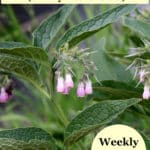
I am an avid reader on just about everything written by Knowledgeable people. I read an article about Canabis where a lady complained that she failed in making her own canabis extract for cancer use as the oil she bought was overly expensive. A kindly soul wrote, It is not just the female plant that is toxic only that it is more toxic than the mail plant.
He explained that male cannabis leaves and stems with the flower head can be chopped up and brought to the boil, then you have to add and oil base to it like Milk, butter, cocnut oil, or other similar substance. and let it simmer at a lower heat for max. 2 hours. drain your liquid and you have your infusion.
Now here is the big question would this preperation work with all medicinal herbs that one require an infusion from, or is specific to cannabis only?
You can make an herbal infusion in oil with most herbs. As to whether this is the best way to use a specific herb, it would depend on the herb. I discuss how to infuse herbs in different substances here.
How can I manage to get Wild Lettuce seeds. I live in South Africa and the plant is indigenous in The United States?
I have been feeding my wife Dandelion Leaves mixed with other salad after her colon cancer operation. She clear of cancer for thirteen years now.
We also asked the surgeon to remove at least 100mm of colon from either side of the infected area and the lymph glands in the area. This he did.
I’m glad your wife’s cancer is in remission. You may wish to include dandelion root, too, as a tincture or decoction or even cook. The roots and leaves have a complimentary effect in the body.
Getting seeds into South Africa from the United States is tricky. I know the websites like Strictly Medicinal stock the seeds, but they cannot/will not ship them to many areas due to shipping/customs restrictions. I see that the seeds are stocked on Amazon.com, but again, I don’t know if they too are prohibited from shipping to South Africa.
Odds are that there are native species with similar properties, or even invasive species that are still common enough to find in the wild. I would try doing some online searches using the scientific name of wild plants from your area, plus the words “cancer” and “study”. This should give you some ideas for plants to try. If you can find a knowledgeable local herbalist, even better.
Mr. Brandt: I also thought of Strictly Medicinals as a source for wild lettuce seed. It is also known by its Latin name, “Latuca virosa”, Using that name might be way to find the seeds from sources close to you. I do know that the owner of Strictly Medicinals, Richo Cheche was quite an adventurer i his younger days, and traveled quite a bit of the world in search of unique and potent herbs for the herb farm he was only dreaming about at that time. I remember that he spent some time in Madagascar, and has listed herbs and spices imported from that country in his catalogue. If he does not export seeds to S. Africa, he may still have contacts in Madagascar who might be able to refer you to an herb source closer to your nation. Another strategy you might find helpful is to contact Mr. Jere Gettle, the owner of Rare Seed Company (rareseed.com). Mr. Gettle’s company searches for heirloom seed internationally. He sponsors people who, like Richo, travel the world looking for productive heirloom vegetable. flower and herb plants whose seeds they bring back to the U.S. to grow, study and hopefully market. Mr. Gettle is a Christian, and a very compassionate man who sponsors relief projects internationally. He might also be able to help you source the seeds you are looking for. May God Bless you and your wife with radiant good health, and an beautiful, abundant life!
If you use comfrey to mulch your vegetables, does the cancer causing agents and the possible liver damage propeyget absorb by your veggies and therefore become unhealthy to eat??
As mentioned in the article, the studies used truly excessive levels on comfrey, and sometimes used the isolated component. If used as mulch, the plants will by default only take the compounds they need. Other plants (unless they are more comfrey) should not bioaccumulate the pyrrolizidine alkaloids.
I’m a bit confused about whether to use the comfrey dried first or fresh when making an oil infusion. Thanks
If you dry the comfrey before infusing it in oil, you’ll reduce the risk of mold growth, but people infuse both fresh and dried herbs.
Laurie,
I’m happy to find your above contributions, thank you.
I was raised around comfrey but have been away from it for about 40 years. I recently found it again and started a crop at the edge of my garden last year. I remember the healing side of the plant and want to start jojoba infused with comfrey and making salves and creams and possibly tinctures.
My question is as follows: I have been sun drying the leaves on stainless steel screens. Covering at night so minimal dew in the morning. Three days of this and the leaves are crispy and ready for crushing. I noticed some of the leave remain green and others turn brown. Do you think the brown ones are bad?
Color change typically indicates oxidation, so the green leaves may have better medicinal properties.
Do you think drying differently would reduce oxidation? If so, I’m open to suggestions or areas where it can be researched as producing a superb product is my goal.
Again, your narratives above are well presented and appropriated.
Quick drying, avoiding excessive heat, and staying out of direct sun help preserve the color. I typically use a commercial dehydrator set at 95F, because we have a lot of humidity in summer.
This gal dries delicate herbs chopped, inside, spread on a flour sack towel.
Is it safe for chickens?
It should be fine in small amounts, free choice, as a supplement. Animals tend to self regulate, as long as they are not under stress or extreme hunger.
I am very allergic to poison ivy and have used comfrey to stop the it h and heal the skin eruptions
Thanks for sharing your experience, Mark.
That is really good to know as my husband reacts strongly to poison ivy. It seems he just has to look at it and he’s got it all over. I get minor little itchy spots if I walk through it. Did you make a salve?
That is awesome to know. And although I have the plant and can make a poultice, I recently discovered on Etsy that somebody is making salve and oil and here I can get it without menthol, which I don’t really prefer to use.
Comfrey is a beautiful plant. And tenacious to a legendary extent. I am a little cautions with introducing herbs like this on our property, since many of the most potent herbs can also become invasive.
For example, I would love to use comfrey as a border plant barrier to weeds, but a neighbor warned me that he, with a property wetter than mine, had serious problems with comfrey becoming uncontrollably invasive. Because of the warning, I have been observing my initial plantings of True Comfrey (Symphytum officinalis) and a Bocking (Russian cultivar that spreads by root) very closely for this reason. Our property is in a wetlands area, but we were in a drought when we moved here and planted each of the varieties, so there were no signs of either plant wandering off until 2 years after the drought ended.
However, I have always carefully clipped the blossoming tips of the True Comfrey off, several hundred beautiful blossoms per year, and dried them for tea. The leaves and stalks have liberally clipped as a chicken treat and fertilizing mulch for our perennials. I have cut it back pretty severely numerous times and it has made it clear to me that it will never die with that kind of mistreatment.
The Bocking just last year, following months of frequent rain, started to spread by root It is planted in a spot where aggressive spreading could do damage to the gravel foundation of our storage building. So far, I can dig up the advancing roots and will be planting those upslope where it remains drier and will give me a handy source of nutritious mulch for my fruit trees.
Regarding health effects, despite having a rather tetchy liver, and kidneys I have had no ill effects from a couple of cups of tea per week, and have noticed that a tendency of my teeth to stain from drinking other kinds of herbal tea is no longer a problem. My guess is that the calcium in the comfrey takes credit for my whiter teeth.
We also fed crumbled, dried comfrey leaves to our hens a few times a week this Winter. Their eggs remained darker than usual until I ran out of the dried leave. The shells also seemed a little thicker, which I hope means their bones remained stronger. They also seemed more excited about their mash with the comfrey in it. We will save more comfrey for them this Summer and Fall.
Thanks for sharing your experience, Sandy. It adds a lot to the post when there are different perspectives from different growing areas.
I wouldn’t expect you to notice anything with your liver until it’s too late. They know that it changes DNA and thus can cause liver cancer in addition to damage to the liver. I work with a lot of patients in the hospital and because the liver is very resilient it’s not gonna be anything you can really notice unless you do an autopsy or unless you actually get a problem and then you won’t be able to do much about it. If you do a risk benefit analysis, I’m not really sure that you want to risk taking it internally, especially twice a week and not trying to treat a particular thing. All of our organs are meant to work and work until they just finally fail and you might not get any symptoms of problems. For instance, did you know that you only need 1/3 of one of your kidneys to be functioning in order to not need dialysis? A lot of people damage their kidneys overtime with untreated, diabetes, or high blood pressure but they’re not gonna have any symptoms of problems until it’s a real bad problem. That’s why high blood pressure gets its name as the silent killer. A lot of people have been using Comfrey for years and didn’t even know it could be so toxic. Like, we used to drink comfrey tea when I was little as well, but now we have excellent access to information telling us that that is not smart whatsoever.
So, the comfrey range map does not show any in texas. Does that mean it won’t grow here, illegal, or just unreported? Of the three types which do you recommend to plant? My dog gets into the garden. Would it be harmful to her?
By the way, love your restrained/video reply above.
The range map means that the wild stuff doesn’t normally show up on its own in Texas, but you can still cultivate it. The seeds can be tough to germinate, but it’s better to start with plants or a piece of root. (I should probably do a post on growing it… I’ll clarify the range map.)
Unless your dog tends to eat large quantities of strange plants, there should not be an issue. Those prickles on the leaves make it unappetizing to most animals – except sheep, because sheep eat anything. (At least that’s what my neighbor says.)
I’ve used comfrey in salve form to ease arthritis pain, and it world! I’m careful to avoid open cuts and use it sparingly, due to the alkaloid. I’m going to try the fertilizer.
One thing to be aware of: if you’re not careful, comfrey will take over your yard. Others have recommended dead heading it to keep it from reseeding.
Brown Blue can kiss my royal Russian—-. What a maroon, as Bugs Bunny would say.
Good additional note about the spreading habit. Some varieties are more prone to spreading than others. Common comfrey spreads more than Russian comfrey (Russian comfrey has sterile seed). I think it depends on soil/garden conditions, too. My little patch has been creeping, not taking over the garden, as it’s in a spot that tends to dry out in the summer.
Some more info on comfrey from Good Life Permaculture:
As a fodder crop, you don’t want to overdo it. The prickles on the leaves tend to naturally limit consumption by animals.
Thanks for sharing the extant science on comfrey consumption and posting the quote on Bocking cultivars. BTW, in Canada, chickens are called “chooks” I experimented with S. officinale and Bocking 12. The S. officinale flowers profusely and continuously all Summer. I am in awe and a little terror over the potential for this beautiful plant to spread, and have been extremely careful to keep it cut back and to collect the blossoms and seeds and dispose of them, since I have been warned by neighbors that it can take over entire gardens. I think this may pertain in particular to areas where there is a lot of rain or soil moisture. I live in a wetlands area. Despite being very careful, have found a couple of comfrey surprises, fortunately where I can keep and eye out and keep them cut back. The Bocking cultivar remained very tidy in a slightly elevated site util we began to get a lot of rain last year. It is now spreading slowly, and I keep it cut back and go after roots to plant uphill around my fruit trees, a much drier zone. All the veggies and fruits get mulched generously with dried leaves and stems down to where it looks like the stem might take root. I dry enough comfrey yearly to powder and give to my chickens once or twice a week in their mash, which they seem to enjoy with no ill effects. I’ll drop a little in our soup once in a while over the Winter to give a little more diversity to our limited diet of dried greens. I do the same with plantain for the flock, which they also seem to perk up over.
Your hands look like someone who uses them. It is hard to believe that comment is real!
WHY DON”T YOU WASH YOUR HANDS?? YOUR FINGERPRINTS ARE FILTHY! WHY??? CAN”T YOU SCRUB THAT ALL OFF?? IT LOOKS SO DIRTY, SURELY YOU’LL GET INFECTED!
Oh you are supposed to be a WOMAN???? DOUBLE SHAME ON YOU for not washing your hands! BE A LADY! Sounds like you were one of those snot-nosed rug rats that your parents allow to run around naked and roll in dirt and go to be without a bath. YUCK! I bet your filth is caked on and permanent unless you soak 2 hours daily in a tub… FOR 10 MONTHS! PS: You got MAN FINGERS!
Amen.
amen! get a life people , why are you here anyways!? Shame on your judgmental …….
I LOVE LOVE LOVE the response to the hateful response that dude or chick put out. I am a woman welder and I remember when I was younger, a dude I worked with said something like “your husband must be disgusted with your hands”. I had never thought about it before and neither had my husband!!! I was taken aback. Hey , usually manual labor is dirty work. That guy is a freaking idiot and a mean one at that!!
Thanks for the great information.
You’re welcome. I too have found that working hands get messy, and that people who have time to make hateful comments could probably be doing something better with their time. Happy, productive people aren’t busy fault picking with others.
Here here, I love his come back!
No one deserves such mean and spiteful comments like you received!
Thank you for sharing all your positive and helpful information. Please keep up your great work as most of us appreciate you in doing so!
I’m an Aromatherapist and a Beauty therapist who loves working out in my garden with my plants and from that my nails nearly always look dirty! It’s not that easy to keep them looking clean, even after scrubbing them! At least my clients understand that nature can and does stain ones hands especially mulberries and tumeric!!!
I wish you many blessings and positive messages🙏🥰
It’s called STAINING. It comes from cutting lots of juicy fruits. Don’t be an idiot.
My hands are stained from plants. The color does not come off.
Who ever that person is evidently has never worked in the yard or garden. Your fingers are clean compared to mine after picking up pecans. Pecans leave stains bleach won’t get off!
Have you ever canned peaches or cherries—well obviously not—you should try it and see how stained your fingers get, and then you wouldn’t look so naive and stupid saying the lady’s fingers are dirty. Yard work also stains hands, and although lemon juice will help the brown looking finger print a little bit, it doesn’t help a lot. Rest assured that the lady’s fingers are not dirty whatsoever. My mom is a nurse and her hands always look like that due to canning and yard work in spite of cleaning them dozens of times in a shift at work. Plus, she’s gonna live a lot longer than you because she actually uses her hands to work and can delicious fruit!
Thanks for the information on Comfrey.
You’re welcome.
I have been using comfrey since I broke my foot in Hawaii in 1979. I had no open wound. I wrapped my foot in a poultice and immediately felt a cooling and the swelling went down immediately. I did not know about the gardening support but now i know why the vegetables I rotate near my comfrey are always the healthiest. Preparing to use as a border for garden. Fall is best time to transplant. Thank you.
Thanks for sharing your experience, Eve.
Hi Laurie, I’ve been researching Comfrey and decided to check what you had to say about it. The article is older so I just thought I’d see if you still feel it would be safe for ingestion for animals. I’m looking for fodder for both our chickens and bunnies. And of course composting as well.
Thanks for your thoughts.
Hi Sharon.
Yes, I still feel that it is safe for ingestion as a part of their fodder (up to 10% for chickens, not sure how much for bunnies). I wouldn’t feed it exclusively, but I wouldn’t feed any one single food exclusively. Also, some animals are less than thrilled to eat it. It helps to wilt it for a day so it’s less prickly before feeding.
I’m wondering if you have heard about using comfrey to regrow teeth? and what do you think of it? I saw it on Natural News.
It’s possible, but I don’t generally trust anything I read on Natural News without double checking their sources. I’ve clicked on their so called sources in the past, and found that they linked to either completely unrelated articles, or articles that did not say what they said they said.
We were warned in our Home Herbalist class to be very careful with comfrey. That it encourages healing to the point that it’s dangerous. If you have an open wound, do NOT use comfrey! It can actually cause the top layer of skin to heal over, while the wound inside does not. But, it is very good for things like bruises, or under skin injuries.
Amanda, thanks for taking the time to reiterate this. I’ll make sure it’s clearer in the post.
I’ve been using comfrey as a mulching agent and fertilizer. I wish I had known about its ability to help heal sprains when I severely sprained my ankle at the end of January.
Will deer eat it? Is it safe around chickens?
Deer will eat comfrey, but normally don’t browse it hard enough to kill it. Comfrey is a good food for chickens.
I love my comfrey both cooked as any leafy greens, and as an addition to my smoothies!
Be careful, it’s toxic to the liver.
It shouldn’t be taken orally for extensive periods of time.
Just wanted to add that in addition to it’s medicinal benefits for humans, comfrey is an amazing plant in the garden. It is a dynamic accumulator. This means is has the ability to draw up nutrients in the ground and concentrate them in it’s leaves. It has a long tap root, so it can reach waaaaay down deep and get to nutrients that are not normally available to most plants. We have comfrey everywhere. We boarder our whole garden with it to keep out the encroaching weeds. We harvest the leaves and use them as mulch in the vegetable garden and forest garden. They are great companions for most fruit trees as well. We also add them to compost pile to accelerate breakdown and make compost tea with them. The flowers attract beneficial insects and we feed some to our rabbits and pigs.
Thanks, Jennifer! My patch is small, so I haven’t used it for that yet (the fertilizer qualities). I remember reading about it a while back but forgot to mention it in the post.
As we are planting our potatoes this spring I will be placing a scoop of dried comfrey with each potato hill. I think this will help the plant have the nutrients it needs as it grows.
Yes, please continue this series! Very informative!